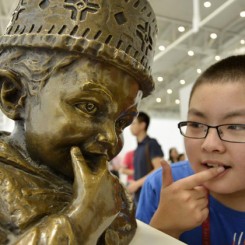On June 25, the first edition of the Xinjiang International Art Biennale opened in Urumqi. The biennale, organized by the Ministry of Culture as well as the Xinjiang Government (in full: the Government of Xinjiang Uyghur Autonomous Region of China), is located at the Xinjiang International Convention and Exhibition Center, taking up over 19 000 sqm. The biennale is curated by Peng Feng, a PhD supervisor at Peking University, and will last until October 8, 2014.
The previous reincarnation of this biennale was the China–Xinjiang Contemporary Art Biennale in 2012, organized by the Xinjiang government, with Urumqi as the fifth city with an art biennale in China. From 2014 onwards, this has been “upgraded” to a national-level event.
This biennale encompasses four main sections—the thematic exhibition, a special exhibition, a focus exhibition, and satelite exhibitions. The theme was set as “Encounters—New Art on the Silk Road”, exhibiting 176 works by nearly 50 artists from 18 countries, with participating Chinese artists including the likes of Cai Guo-Qiang, Xu Bing, Zhang Xiaogang, Chen Danqing, Yang Feiyun, among others. The special exhibition, meanwhile, showed off around 100 paintings from the collections of the “Xueliantang” Museum (lit. “Hall of the Snowy Lotus”) of the Xinjiang Guanghui Industry Investment Group; works include those by modern Chinese masters like Xu Beihong, Lin Fengmian, Fu Baoshi, Qi Baishi, Zhang Daqian, Pan Tianshou, Li Keran, Shi Lu, Huang Zhou. The parallel exhibitions display drafts, documents, and archival material from Fang Lijun, as well as the huge quadriptych and video work made by Liu Xiaodong in Xinjiang.
Xinjiang, or “Xinjiang Uyghur Autonomous Region”, with its religious and cultural differences, has long led a troubled existence within China—most notably with the recent spate of terrorism. In particular, in May this year, Urumqi experienced coordinate attacks that killed 31 people. In this light, this biennale, organized by the government, does not merely have cultural or artistic significance but much like the “Silk Road” forms a larger political project.
Indeed, there have been reports that Nikita Kadan was forced to withdraw due to the “political issues” in the work. ArtLeak even has a source that claimed a staggering 80 artists out of the 120 international artists originally invited to the biennale were rejected.
